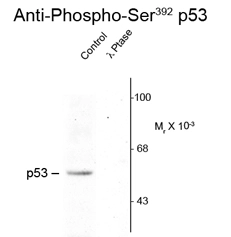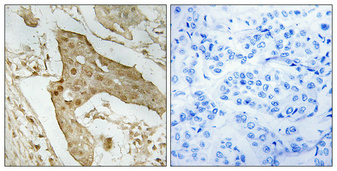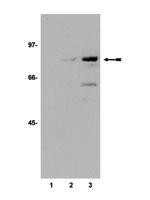
Western blot of rat brain nuclear fraction lysate showing specific immunolabeling of the ~53k using p53 (phospho Ser392) antibody (GTX23257) p53 phosphorylated at Ser392 (Control). The phosphospecificity of this labeling is shown in the second lane (lambda-phosphatase: lambda-Ptase). The blot is identical to the control except that it was incubated in lambda-Ptase (1200 units for 30 min) before being exposed to the phospho Ser392 p53 antibody. The immunolabeling is completely eliminated by treatment with lambda-Ptase.
p53 (phospho Ser392) antibody
GTX23257
Overview
- SupplierGeneTex
- Product Namep53 (phospho Ser392) antibody
- Delivery Days Customer9
- ApplicationsWestern Blot
- CertificationResearch Use Only
- ClonalityPolyclonal
- ConjugateUnconjugated
- Gene ID7157
- Target nameTP53
- Target descriptiontumor protein p53
- Target synonymsantigen NY-CO-13; BCC7; BMFS5; cellular tumor antigen p53; LFS1; mutant tumor protein 53; P53; p53 tumor suppressor; phosphoprotein p53; transformation-related protein 53; TRP53; tumor protein 53; tumor supressor p53
- HostRabbit
- IsotypeIgG
- Protein IDP04637
- Protein NameCellular tumor antigen p53
- Scientific DescriptionThis gene encodes a tumor suppressor protein containing transcriptional activation, DNA binding, and oligomerization domains. The encoded protein responds to diverse cellular stresses to regulate expression of target genes, thereby inducing cell cycle arrest, apoptosis, senescence, DNA repair, or changes in metabolism. Mutations in this gene are associated with a variety of human cancers, including hereditary cancers such as Li-Fraumeni syndrome. Alternative splicing of this gene and the use of alternate promoters result in multiple transcript variants and isoforms. Additional isoforms have also been shown to result from the use of alternate translation initiation codons from identical transcript variants (PMIDs: 12032546, 20937277). [provided by RefSeq, Dec 2016]
- Storage Instruction-20°C or -80°C,2°C to 8°C
- UNSPSC12352203



![ICC/IF analysis of HeLa cells using GTX27757 p53 antibody [BP53-12].](https://www.genetex.com/upload/website/prouct_img/normal/GTX27757/GTX27757_20191025_AP_002_194_w_23060722_732.webp)


